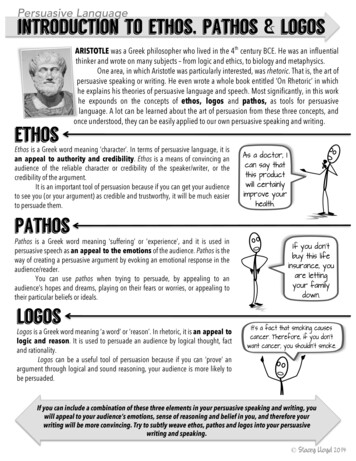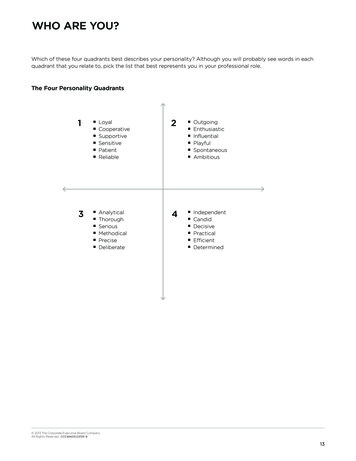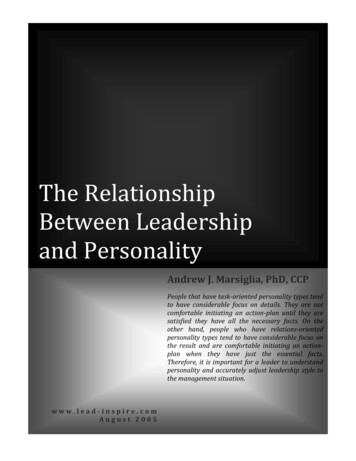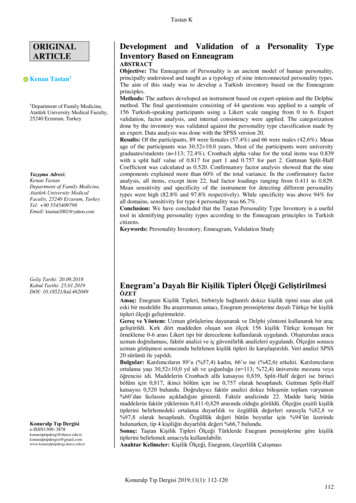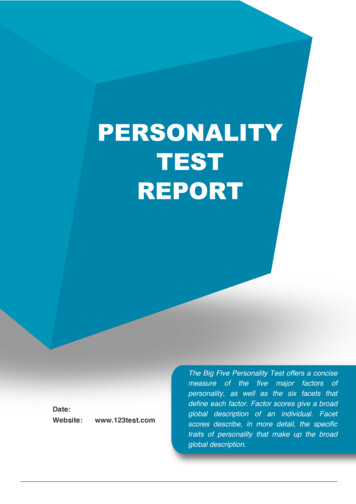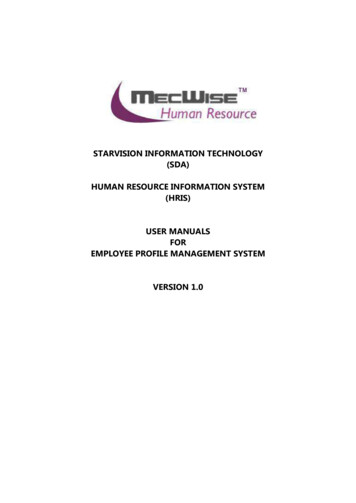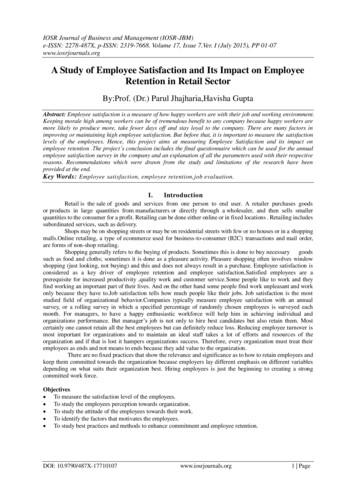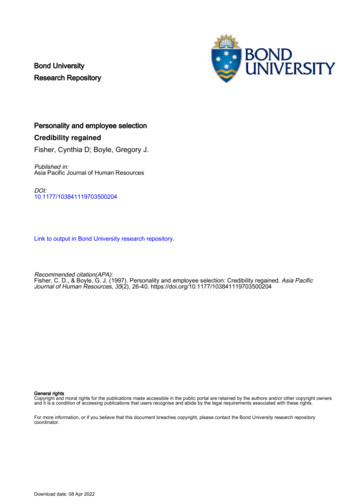
Transcription
Bond UniversityResearch RepositoryPersonality and employee selectionCredibility regainedFisher, Cynthia D; Boyle, Gregory J.Published in:Asia Pacific Journal of Human ResourcesDOI:10.1177/103841119703500204Link to output in Bond University research repository.Recommended citation(APA):Fisher, C. D., & Boyle, G. J. (1997). Personality and employee selection: Credibility regained. Asia PacificJournal of Human Resources, 35(2), 26-40. https://doi.org/10.1177/103841119703500204General rightsCopyright and moral rights for the publications made accessible in the public portal are retained by the authors and/or other copyright ownersand it is a condition of accessing publications that users recognise and abide by the legal requirements associated with these rights.For more information, or if you believe that this document breaches copyright, please contact the Bond University research repositorycoordinator.Download date: 08 Apr 2022
Personality and Employee Selection:Credibility RegainedCynthia D. FisherSchool of BusinessBond UniversityGold Coast QLDAustralia075595 2215fax 07 5595 1160Gregory J. BoyleDepartment of PsychologyBond UniversityGold Coast QLDAustralia0755952525fax 07 55952545
1Personality and Employee Selection:Credibility RegainedConceptual and methodological advances on both the predictor and criterion side andseveral influential meta-analytic reviews have contributed to a resurgence of credibility forpersonality as a predictor in employee selection. This paper reviews the prior problems withpersonality as a predictor, summarises research findings on the effectiveness of personality inselection, and lays out the circumstances under which personality measures are most likely to beuseful. The most consistent findings are that personality measures such as integrity andconscientiousness predict contextual and motivational aspects of performance reasonably well.Suggestions for future research on personality in selection are made, and human resourcemanagement implications of personality-based selection are discussed.
2Personality testing for employee selection has had a chequered history. Over the years,considerable research attempting to validate personality instruments for selection has beenconducted. An early review by Guion and Gottier (1965) pointed out that predictive validitiesfrom personality questionnaires appeared to be weak and inconsistent. Academics took thismessage to heart and began to discourage the use of personality instruments for hiring purposes.Consequently, research on personality and job performance virtually went into hibernation for 20years. Human resource practitioners, however, continued to believe that personality was animportant predictor (Dunn, Mount, Barrick, & Ones, 1995).Criticisms of personality testing in selection have included: poor criterion related validity,potential faking by applicants, unfairness, limited face validity, and invasion of privacy (cf.Hogan, 1991). Fairness may be breached because applicants may incriminate themselves withoutbeing aware of what they are doing (the purpose and coding of items is not obvious), there isusually no feedback of test scores and no appeal process, and little explanation for the choice anduse of the particular instrument is given to applicants (Harland, Rauzl, & Biasotto, 1995). Facevalidity and privacy suffer when questionnaire items cover sexual fantasies and other personalbeliefs and behaviour in the non-work domain.Resurgence of Interest in Personality Testing for SelectionRecently there has been a major resurgence in academic interest in personality testing foremployee selection. A number of factors have contributed to this: literature reviews using metaanalytic techniques, the use of typologies of personality traits to organise past validation studies,more sophisticated conceptualisations of the performance criteria to be predicted, the developmentof personality measures more closely focused on job demands, and reassuring research on fakingby applicants. Each of these will be discussed below, while specification of exactly whichpersonality variables appear to predict which aspects of job performance will be deferred until alater section of the paper.
3Meta analytic reviews by BarTick and Mount (1991, updated in Mount and Barrick, 1995)and Tett, Jackson, and Rothstein (1991) suggested that some personality variables weresignificant predictors of some aspects of performance, with mean validity coefficients correctedfor unreliability as high as .45 across occupational groups. Central to these reviews was theadoption of the "Big Five" personality typology as a means of organising previous studies whichused a large variety of specific trait measures. One of the more interesting findings of Tett et al.was that validity coefficients were much stronger in studies in which personality predictors werechoscn on the basis of theory and job analysis (r .38) than in those in which they were not (r .12). Schneider and Hough (1995, p. 87) likewise criticised blindly empirical research in which"Predictors are hurled against criteria in the hope that some will stick." A more theory-basedapproach to understanding both personality and job performance constructs seems needed toclearly forecast when, why, and how personality variables may be expected to predict jobbehaviour. Substantial progress on such a framework has been made during the past decade.Campbell (1990) has sounded a call for a "theory of performance" to improve theunderstanding and prediction of job performance (see Cooksey and Gates, 1995, for a competingmodel). Such a theory would specify the distinct components of job performance and the likelydeterminants of each component. This framework would be useful in generating hypothesesabout which aspects of performance are best predicted by personality or other types of predictors.Campbell's initial suggestion for a typology of job performance included seven components: jobspecific task proficiency (performance on core technical aspects of the job), nonjob specific taskproficiency (tasks most incumbents have to do, regardless of specific occupation), written andoral communication, maintaining personal discipline, facilitating peer and team performance,supervision, and management/administration. Several of the meta-analyses of personality testvalidity have also found it necessary to consider multiple aspects of job performance, not justglobal measures of overall performance.While the exact number of components needed to cover the domain of performance in themajority of jobs is not yet agreed, recent research suggests that at least two very distinct aspects
4of perfonnance must be considered: task perfonnance, and contextual performance (Motowidlo& Van Scotter, 1994). Contextual perfOlmance includes Campbell's personal disciplinedimension, Barrick and Mount's personnel data criterion, and activities elsewhere called lawabiding, organisational citizenship, extra-role, or prosocial organisational behaviour. Specificbehaviours include following rules, attending work reliably, volunteering for extra duties, beingcooperative, and supporting the organisation in a variety of discretionary ways. Others havefocused on the negative side of contextual performance: irresponsible, counter-productive, or"deviant" behaviours such as quitting, being absent, stealing, and being the target of disciplinaryactions.Motowidlo and Van Scotter found that supervisors are capable of distinguishing betweentask and contextual performance when making ratings, and that both aspects contributeindependently to ratings of overall perfonnance. Research quite clearly shows that personalitypredicts contextual perfonnance better than task perfonnance. Earlier studies that focused onlyon overall performance or objective measures of job proficiency quite understandably producedlow average validities for personality measures.Advances in personality testing have also helped improve the credibility and predictiveability of tests in the employment setting. Earlier instruments such as the Minnesota MultiphasicPersonality Inventory (MMPI) were designed to identify diagnosable mental disorders, and wereof limited use in normal populations of job applicants (see critique by Helmes & Reddon, 1993).The development of instruments (such as the California Psychological Inventory -CPI) suited toassessing general (non-clinical) populations was a step forward. (See McAllister 1986 for adviceon using the CPI in selection.) Factor analytically based instruments such as the SixteenPersonality Factor Questionnaire (l6PF) have been developed to assess overall source traits (seeCattell, Cattell, and Cattell, 1994). The NEO Personality Inventory has been specificallydesigned to assess the Big Five personality dimensions, with six subfactors in each Big Fivedimension (Costa and McCrae, 1992). Hogan set out to produce a six-factor instrument thatassessed the ability of normal adults to adapt and get along in society (see critique by Boyle,
51992). The Hogan Personality Inventory's six dimensions (intellectance, adjustment, prudence,ambition, sociability, likeability) are comprised of "homogeneous item composites (HICs)"internally consistent clusters of items that measure one of 45 more precise characteristics such asself-esteem, cooperativeness, and autonomy. A number of studies have used these HICs toconstruct customised inventories aimed at the demands of particular jobs. Examples include theSales Potential Inventory (Hogan, Hogan, & Gregory, 1992), the Claims Examiner Inventory(Arneson, Millikin-Davies, & Hogan, 1993), and the Service Orientation Index (Hogan, Hogan,& Busch, 1984). Additional advances have been made in the development and validation of job-relevant personality-like tests of honesty, integrity, and employee reliability (Ones, Viswesvaran,& Schmidt, 1993).In Australia at the present time, the 16PF, CPI, and the Occupational PersonalityQuestionnaire (OPQ, Saville & Holdsworth, 1990-1994) seem to be the most commonly usedpersonality inventories in the selection context. Both the 16PF and the CPI have a longestablished history of use in this regard, whereas the OPQ is a more recently constructedinstrument which incorporates some of the features of the 16PF (see review by Haladyna 1992).A further perceived impediment to the use of personality instruments was the concernabout fakability, though simple motivational distortion in responses can be detected with the "lie"or social desirability scales built into many inventories. Research has shown that respondentscan raise their scores when instructed to "fake good," though they can "fake bad" even better.However, applicants generally do not seem to distort their responses very much, and validity isnot affected. Only random responding destroys validity (Hough, Eaton, Dunnette, Kamp, &McCloy, 1990). Some scholars have suggested that choosing to distort and present oneselfpositively can be a useful predictor of job success. Applicants who are socially sensitive enoughto present themselves favourably may be better at getting along in the social world, and maymake better employees (Schmit, Ryan, Stierwalt, & Powell, 1995; Seisidos, 1993). However,there is not yet sufficient evidence to either support or refute this proposition. For example,
6Hough et al. did not find evidence that favourable self-presentation was related to jobperfonnance in their military sample.Dimensionality of Personality in the Selection ContextA very major issue for many researchers is how the personality domain should beconceptualised and measured. There are several typologies of personality traits at a high level ofgenerality: The Big Five advocated by Costa and McCrae (1988), Goldberg (1990), Mount andBarrick (1995), and others (see critique by Block, 1995); the 16 source trait factors and the sixsecond-order factors delineated by Cattell (see Krug & Johns, 1986); the three typological factorsof Eysenck (1991); the six factors used by Hogan; and the nine categories Hough (1992) foundnecessary to organise previous research on the validity of specific traits for predicting jobperfonnance. Table I lists these typologies. A detailed exploration of the empirical evidence foreach is beyond the scope of this paper (cf. Boyle, 1989). Suffice it to say that some researchersfeel that five traits is too few for predicting job performance, and that the so-called Big Five bothexclude relevant individual difference constructs (eg. Boyle, Stankov, & Cattell, 1995) andcombine into single dimensions other attributes which are distinctly and differently related to jobbehaviour criteria (Hough, 1992; Schmit & Ryan, 1993).****Insert Table I About Here****Regardless of which typology is adopted as an overarching framework, a further issuearises in whether for prediction purposes, traits should be assessed at the highest and broadestlevel, or if more specific traits should be measured and used as separate predictors. It seemsdoubtful that measures at the macro level of extraversion, neuroticism, and psychoticism wouldprovide the fine-grained infonnation needed to predict job success in specific occupations, eventhough Eysenck's typology is well supported in the personality literature. Mershon and Gorsuch(1988) have shown empirically that more and more specific traits provide better prediction thanfewer general factors. They compared the use of all 16 scales of the 16PF to the use of summary
7measures of the 16PF's higher-order factors, and found that the prediction of criteria such assalary, tenure, performance, and occupation membership was nearly always better when the 16individual traits were used. Measurement and validation at the level of specific traits is alsoexpected to shed more light on a theory of the causes of distinct aspects of performance(Schneider, Hough, & Dunnette, 1996).One the other hand, Ones and Viswesvaran (1996) make a convincing argument for thereliability and predictive validity of broad trait constructs, such as the Big Five, over the narrowertraits that comprise each Big Five construct. They argue both logically and empirically that mostjob performance criteria are broad and multi-dimensional, necessitating an equally broad predictorconstruct. In a reply to this paper, Hogan and Roberts (1996) point out that the broadness orspecificity of the predictor needs to match the broadness or specificity of the performancecriterion, meaning that there is a time and place for both broad and specific personality traitmeasures.What Works - Specific Findings on Personality-Performance RelationshipsIf job performance is viewed as a multiplicative function of ability (can do) andmotivation (want to do), then both ability measures and stable dispositional factors indicative ofmotivation should be useful predictors of job success. The case for ability measures has alreadybeen made convincingly (Hunter, 1986). Some personality attributes, such as achievementorientation and conscientiousness, are probably good indicators of motivation and should beuseful in predicting job success. In fact, there is now an overwhelming body of evidenceshowing that measures of integrity, reliability, prudence, dependability, conscientiousness, andachievement orientation are significantly related to contextual performance on many jobs (cf.Banick & Mount, 1991; Mount and Barrick, 1995; Murphy, 1993; Ones et al. 1993; Sackett,Burris, & Callahan, 1989). In some cases, these types of personality constructs alsosignificantly predict task performance/proficiency, but usually not as strongly as they docontextual performance (McHenry, Hough, Toquam, Hanson, & Ashworth, 1990; Motowidlo
8& Van Scotter, 1994). It makes sense that motivation should influence behaviour most subject tovolitional control by individuals, while motivation/personality measures alone will be less able topredict task performance when ability is also required.There have been several influential meta-analytic reviews of personality-perfonnancerelationships over the past few years. The reviewers agree that some personality measures cancontribute to the prediction of some aspects of job perfolmance. However, the detailedconclusions reached by the various reviewers do not always agree, and it would be premature tomake blanket recommendations about validity generalisation (with the probable exception ofintegrity).Barrick and Mount's (1991) review based on the Big Five has received the mostattention. These authors reported that across all job categories studied, conscientiousness wasthe only characteristic which was related to all three categories of performance criteria (jobproficiency, training proficiency, personnel data) across all job categories studied (estimated trueAcorrelation (p) .22). Training proficiency was predicted by intellectance/openness toexperience(p .25), extraversion (p .26), and conscientiousness (p .23).Both sales andmanagerial success were significantly predicted by extraversion. However, the magnitudes ofthe uncorrected mean correlations were quite modest, .15 or below, accounting for very limitedproportions of the variance in the criterion. A 1995 update of this meta-analysis found thatconscientiousness predicted "will do" performance criteria like reliability, effort, and quality withan estimated true validity of .45, and predicted "can-do" ability-based criteria on average .22(Mount and Barrick, 1995).Tett et al. (1991) used somewhat different criteria and procedures in their meta-analysis,and produced generally higher validity estimates than the original Barrick and Mount work. Theyfound that agreeableness, openness to experience, and neuroticism (negatively) were moststrongly related to job performance. The mean correlation for conscientiousness was positive,but this construct was not as useful in their study as it was in Barrick and Mount's analysis.
9Hough's (1992) meta-analysis concluded that different personality traits predict differenttypes of criteria. For instance, she found that locus of control and achievement predicted trainingsuccess and overall pelformance; dependability, achievement, and adjustment predicted lawabiding versus irresponsible behaviour; potency and achievement predicted managerialproficiency; and affiliation, potency, achievement, adjustment, and locus of control predictedsales effectiveness. Interestingly, creativity was negatively predicted by affiliation andagreeableness, suggesting that more isn't always better, even on stereotypically "good"dimensions.While a number of types of tests have recently shown promising validity in predictingaspects of job performance, integrity tests provide the most striking and surprising success story.Two types of integrity tests are available: those that are overt, focusing on attitudes toward theftand past dishonest behaviour; and those that are more personality-oriented, assessing generalconscientiousness, impulse control, rule following, dependability, and the like. Personalitybased integrity measures seem to owe their effectiveness to combining conscientiousness,agreeableness, achievement, dependability, and emotional stability into a composite that outpredicts any of its individual components (Collins & Schmidt, 1993; Murphy & Lee, 1994;Ones, Schmidt, & Viswesvaran, 1994). A meta-analysis by Ones et a!. (1993) provides strongevidence for the cross-situation and cross-occupational validity of these instruments forpredicting both job performance and counter-productive behaviours. Integrity tests predict notjust employee theft, but also a wide range of counter-productive behaviours. Mean correctedvalidity coefficients of up to .41 were found. Organisational level time series studies of integritytests have also shown interesting results, with shrinkage and terminations for cause decreasingsubstantially following the adoption of integrity tests in selection (see Sackett et a!., 1989, for areview).These robust results led Ones to speculate that integrity may be the personality equivalentto general mental ability in the cognitive domain: valid for virtually all jobs and often superior tomore specific trait measures (see also Mount and Barrick, 1995 for a discussion of the
10"functional personality" at work). Given these findings, employers could probably adopt one ofthe more reputable integrity tests on the basis of validity generalisation, and forgo doing theirown validation study. However, with low base-rate behaviours like employee theft and seriouslynon-compliant behaviour, the problem of false positives (erroneously rejecting employees whowould not have stolen or been non-compliant) will remain severe (Murphy, 1993).Some studies have focused on identifying the personality traits which are most useful inpredicting success in specific occupational fields. A meta-analysis by McDaniel and Frei (1994)suggested that measures of customer service orientation were significantly related to performancein service jobs, with a mean corrected correlation of .50. Like integrity, customer servicemeasures also seem to tap conscientiousness, emotional stability, and agreeableness (Hough &Schneider, 1996).In the managerial realm, success has been found to be significantly correlated withpotency, adjustment, achievement, extraversion, and need for advancement (Barrick & Mount,1991; Bray & Howard, 1983 Hough, 1992). Bentz (1985) reported on decades of research onpersonality and managerial performance at Sears, a major U.S. retailer. In summarising theresults of work on manufacturing managers, he described the successful "CompetitiveLeadership Syndrome" as follows (p. 112):"Persuasive and socially assured, the person moves aggressively into a central rolewhenever part of a social or business group (Sociability, Social Ascendancy, PersuasiveInterests). Confident to initiate and act without external support (Self-Confidence), theindividual catches on rapidly (Mental Ability) and moves into action with energy andflexibility (General Activity and Serious versus Carefree). With heightened personalconcern for status, power, and money (Political and Economic Values), the person willwork hard to achieve positions that yield such rewards."It is quite apparent that personality does contribute meaningfully to the prediction of someaspects of job success. Personality measures are usually uncorrelated with ability measures, so
11they may add unique variance to the prediction of job perfol1nance (cf. Rosse, Miller, & Barnes,1991). However, it is necessary to caution that most of the meta-analytic studies mentionedabove (Hough excepted) have corrected the observed validity coefficients for both predictor andcriterion unreliability. This is useful in determining construct-to-constmct relationships, but itover-estimates the validity that would actually be achieved in using less than perfectly reliableinstruments in a selection context. We will next consider how and when personality is likely tobe most useful in selection.How and When does Personality Predict Performance?There seem to be two implicit theories underlying research on personality in selection: theperson-job match theory, and the "good apple" theory. The former says that the personality traitsneeded for different jobs and occupations might be quite different, and that getting the match rightis critical. Stereotypically, one might recommend choosing extraverts for sales job and introvertsfor book-keeping jobs. Unfortunately, the meta-analytic work is not yet able to offer extensiveguidance on trait choices for different occupations (other than service orientation for servicejobs), partly because number of studies in each job category is insufficient for conclusiveanalyses. In order to apply this approach, further developments on taxonomies of personalityrelevant to work and personality-oriented job analysis methods will be necessary. With thesetools, it may be possible to assess the likely personality requirements of different jobs, then selectmeasures which will predict performance on those jobs.The good apple approach says that most good employees share traits of being honest andconscientious and stable and probably agreeable, and that these traits should be selected forregardless of the specific occupation. This view has received support from several meta-analyticstudies (Barrick and Mount, 1991, Ones et aI., 1993, Ones & Viswesvaran, 1996; Tett et a!.,1991), and is also consistent with managerial beliefs about what traits are generally important inemployee selection (Dunn et a!., 1995). A more sophisticated version of this approach points outthat different traits predict different behaviours, and if behaviours like exerting effort, obeying
12rules, and getting along with others ate important in a particular job, then measures ofachievement, dependability, and the like should contribute to the prediction of job success(Hough, 1992).How exactly do personality attributes become converted into job performance? In thecase of contextual behaviour, conscientiousness and integrity may work simply by increasing thechances that employees will choose to attend work, obey the rules, and be helpful and pleasant.In the case of task performance, conscientiousness and similar traits may increase time on task,effort, persistence, and attention to detail, which may beneficially impact performance on somejobs. There is also evidence that personality variables such as conscientiousness andachievement motivation may affect performance via the intermediate steps of spontaneous goalsetting and goal commitment (Austin & Klein, 1996; Barrick, Mount, & Strauss, 1993).Finally, there is evidence that personality sometimes interacts with ability to predict performance(Hollenbeck, Brief, Whitener, & Pauli, 1988; Wright, Kacmar, McMahan, & Deleeuw, 1995).Both of these studies showed that when ability is low, motivation (in the form of internal locus ofcontrol, high self esteem, or achievement need) can be problematic, as employees try very hard toperform tasks they are incapable of carrying out correctly and thus compound their errors relativeto low ability people who are less motivated. However, when ability is high, the samepersonality variables are positively related to performance.It has long been thought that dispositional variables will predict behaviour better in"weak" situations allowing discretion than in "strong" situations which suppress the display ofindividual differences (Mischel, 1977). There is relatively little research addressing this issue inthe case of personality and job performance, but the studies that have been done tend to supportthe above assertion. For instance, the meta-analysis of integrity tests by Ones et al. (1993) foundthat validity was much higher in more complex jobs. They speculated that this was because morecomplex jobs were less closely supervised and allowed more opportunity to engage in dishonestyif the employee was so inclined. BarTick and Mount (1993) found that autonomy moderated thevalidity of conscientiousness, extraversion, and agreeableness, such that personality
13characteristics were more predictive of perfonnance when autonomy was high. Oldham andCummings (1996) found that a personality-based measure of creativity was more predictive ofactual on-the-job creative behaviour under the facilitating conditions of high job complexity andnon-controlling supportive supervision.Personality is also more likely to predict performance over longer time periods, andperhaps when cognitive ability is relatively less important. This suggests that personality mightnot be a strong predictor of near term perfonnance during training or immediately after hire whenlearning abil ity is crucial, but may become more imp0l1ant in maintaining perfonnance after jobskills are mastered. Helmreich, Sawin, and Carsrud (1986) reported that the validity ofpersonality predictors increased over the first eight months of employment for airline reservationagents. Long tenn studies of managerial success at AT&T and Sears also confirmed thatpersonality variables have substantial predictive power over a 10 to 20 year career (Bentz, 1985;Bray & Howard, 1983; McClelland & Boyatzis, 1982).In summary, personality predictors are most useful over the longer term, on jobs inwhich perfonnance is not highly constrained by ability, job design, or organisational controlsystems, and when predicting contextual aspects of performance.Future Research NeedsThere is still room for additional research on applied personality assessment in selection.More work is needed on the fonn of the predictor-criterion relationship, which traits aremeasured, and how they are measured.Alternative fonns of the predictor-criterion relationship should be explored. The typicallinear validity paradigm has been criticised by Campbell (1990), and in the case of personality,non-monotonic relationships seem quite possible. For instance, optimal perfonnance in somecases may be associated with intennediate rather than high or low levels of traits such asdominance. Another possible form of the relationship would be a cutoff threshold (e.g., negativeselection procedures as used by the Australian Anny Psychology Corps). Personality
18ReferencesArneson, S., Millikin-Davies, M., Hogan, J. (1993) Validation of personality and cognitivemeasures for insurance claims examiners. Joumal ofBusiness and Psychology 4: 459-473.Austin, J.T. and Klein, 18. (1996) Work motivation and goal striving. In K.R, Murphy (Ed.),Individual Differences and Behavior in Organizations. (pp. 209-257). San Francisco:Jossey-Bass.Barrick, M.R. and Mount, M.K. (1991) The big five personality dimensions and jobperformance: A meta-analysis. Personnel Psychology, 44: 1-26.Barrick, M.R. and Mount, M.K. (1993) Autonomy as a moderator of the rleationship betweenthe Big Five personality dimensions and job performance. Journal ofApplied Psychology,78: 111
Sales Potential Inventory (Hogan, Hogan, & Gregory, 1992), the Claims Examiner Inventory (Arneson, Millikin-Davies,& Hogan, 1993), and the Service Orientation Index (Hogan, Hogan, & Busch, 1984). Additional advances have been made in the development and validation ofjob relevant personality

